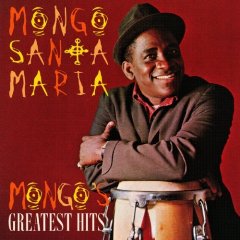Mongo Santamaria – Mongo's Greatest Hits (1995/2006)
Mongo Santamaria – Mongo's Greatest Hits (1995/2006)

1 Afro Blue 3:55 2 Mi Novia 2:50 3 Linda Guajira 3:06 4 Pito Pito 2:43 5 Mazacote 10:38 6 Para-Ti 3:01 7 Watermelon Man 2:20 8 Manteca 5:25 9 Sabroso 3:40 10 Conga Pa Gozar 4:05 11 Federico 3:25 12 Mi Guaguanco 4:35 13 Para Ti (Alternate) 6:02 14 Las Guajiras 7:44 The Mongo Santamaria Orchestra Mongo Santamaria - Composer, Congas, Percussion Francisco Aguabella - Congas Willie Bobo - Timbales Rudy Calizado Vocals Rudy Calzado Vocals João Donato - Piano Modesto Duran - Congas Felix "Pupi" Legarreta - Violin Rolando Lozano - Flute Armando Peraza - Bongos, Congas, Percussion Niño Rivera - Tres Jose "Chombo" Silva - Sax (Tenor) Carlos Vidal - Congas, Percussion Willie 3030 - Timbales Carlos Yidal - Congas, Percussion
This is a excellent single-disc sampler of what Mongo Santamaria was like before "Watermelon Man" catapulted him into the charts. Some of the Fantasy tracks sound like the musicians were just off the boat from Havana, and are a bit primitive in contrast to the brassy Santamaria of the mid- to late '60s, but they have overwhelming charm. The revered "Afro-Blue" can be heard in its original, spooky, stripped-down form, and it would be hard for anyone to resist the voodoo spell that the ten-plus minute "Mazacote" conveys. Besides Santamaria himself, included among the world-class percussionists on this record are Willie Bobo and Armando Peraza. The CD version adds four tracks, including "Watermelon Man" from the Battle/Riverside period and an alternate take of "Para Ti." --- Richard S. Ginell, Rovi
Born and raised in Havana, Cuba, Ramón “Mongo” Santamaría established himself as one of the premier congueros (conga players) in the Havana dance band scene.
In the late 1940s he played with Orquesta Casino de la Playa, where he met Pérez Prado, and when Prado moved to Mexico City in 1948 to start his own band, Santamaría went with him. In 1950 he travelled with Prado to the U.S., where legendary bandleader Tito Puente saw him play in New York and recruited him for his own band. Santamaría played with Puente for six years, during which time his reputation grew with American audiences and musicians.
In 1957 Santamaría went to San Francisco at the invitation of vibraphonist and Latin jazz combo leader Cal Tjader and there he began to record his own albums, establishing himself as an innovator in the fusion of Latin rhythms with jazz and pop music. His cover of Herbie Hancock’s Watermelon Man reached Number 10 on the pop charts in 1963 and his own composition, Afro Blue, first recorded in 1959, became a Latin jazz standard.
Mongo Santamaría’s powerful playing and outgoing nature made him an inspiration to percussionists in diverse music scenes and helped make the conga drum an important instrument in U.S. pop music. --- americansabor.org
download (mp3 @320 kbs):
yandex 4shared mega mediafire zalivalka cloudmailru uplea








